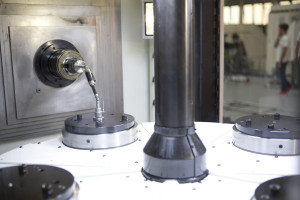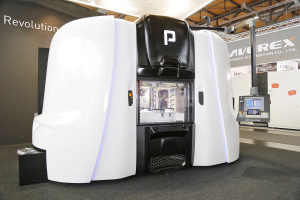
In recent years, several manufacturers of fixtures, fittings and components that come in contact with drinking water have had a tough time with the processing of their components which, as requested by government standards, must be totally lead-free.
This lead-free brass has a family that ranges from the well-known ECOBRASS up to the terrible and feared C511L which, on the one hand is an excellent material since it does not contain lead, harmful to human health, but on the other hand it has spread panic among the producers of these components.
Allow me to explain why: by eliminating lead from the brass alloy, the material is no longer workable, so the production machines used up to that time become totally useless, since they would immediately cause the following four 4 problems:
INSUFFICIENT POWER TO THE MOTORS – CHIPS OF INFINITE LENGTH – VIBRATION DURING PROCESSING – EXTREMELY LONG CYCLE TIMES
With the 4 four problems listed above, it is easy to understand why companies get into a panic the moment they need to process this material and the deliveries to their end customers are postponed, causing serious problems to the sales office.
If you are reading this article, perhaps you are also in search of information and understand very well what I am trying to say when you experience these situations: the level of stress rises, and the atmosphere is certainly not conducive to finding a solution to this serious problem.
All of a sudden, it’s as if your company is no longer able to process components that, on the outside look like normal brass but that, underneath, hide a steel core that puts both machinery and personnel in a difficult situation.
LEAD-FREE BRASS: THE BRASS-COLOURED STEEL
What does this statement mean?
That if we find ourselves having to process a lead-free brass component it would be a mistake to do as we have always done.
By continuing to apply brass-related techniques and rules.
Actually, an effective way to solve the problem is to pretend to have in your hands not lead-free brass, but instead a steel component.
Surely, thinking of tooling for steel you would never start to use brass tools in order to work such a component.
In the case of lead-free brass, this is the typical mistake that is repeated over and over.
Moreover, with traditional brass we were accustomed to combining various processing phases in a single tool, using form tools.
On the contrary, when it comes to steel, for each diameter to be worked there are usually dedicated tools in order to find the right cutting speeds.
Staying on the subject of steel, in addition to separating the various diameters into multiple tools, there is normally more power demanded of the spindle motor since, as you very well know, steel requires more power.
THIS IS WHY EVERYTHING GOES HAYWIRE WHEN YOU HANDLE THIS MATERIAL IN A TRADITIONAL MANNER.
This problem of lead-free brass represents a wrong approach to the type of material which, if properly dealt with, is actually no problem at all.
In fact, the wrong attitude consists of pretending to process a steel component using techniques and rules that apply to a brass component.
WHAT ARE THE CHANCES OF SUCCESSFULLY PROCESSING A STEEL COMPONENT USING TECHNIQUES AND RULES THAT APPLY TO BRASS?
ZERO!
Now that you have understood how to solve this problem, try to change your attitude and start from scratch, both in terms of the tooling and of the division of the processing phases, dedicating simple tools to the various processes so that you can find the right cutting speed.
After doing this exercise, the main problem is to adapt it to the machines installed at your production department which, in most cases, are machines with TRANSFER technology, thus resulting in the following problems:
- INSUFFICIENT NUMBER OF WORK UNITS SINCE THE OPERATIONS HAVE BEEN DIVIDED
- INSUFFICIENT SPINDLE POWER
- NO CUTTING COOLANT AVAILABLE
- HIGHLY PROBLEMATIC EVACUATION OF LONG CHIPS
These four issues in fact thwart the effort of producing lead-free components, leading the producer into the temptation of re-grouping together the tools in order to stay within the number of units available on the transfer machine, but unfortunately this does not work.
Recently, the success that the MULTICENTER has had on the market is also partially thanks to the introduction of this lead-free brass, and I will now explain the reason for this.
Just take the 3-SPINDLE MULTICENTER and, by selecting a simple power increase function that is normally used for steel components, the machine is ready to produce components made with lead-free brass with no problems whatsoever.
From 2005 to 2013, the MULTICENTER was produced in the BRASS/ALUMINIUM version and in the CAST IRON/STEEL version.
These two machines were conceptually identical, the only difference being the bases, which differed in relation to the material to be processed.
In 2013, at the Machine Tool World Tradeshow (EMO, Germany), the single model of the new 3-SPINDLE MULTICENTER made its debut.
In other words, the base of the CAST IRON/STEEL MULTICENTER was redesigned in collaboration with the UNIVERSITY OF BRESCIA, Faculty of Mechanical Engineering, and since then, it has been sold as a single model for all kinds of material – rigid enough for steel, cost effective for lighter operations.

AND NOW HERE IS HOW WE SOLVED A CASE INVOLVING LEAD-FREE BRASS….
One of our U.S.-based customers put out a challenge concerning our 3-SPINDLE MULTICENTER: he wanted to produce one of his products in brass, both with lead and lead-free.
At the time, the customer was producing this component up to a 2″ size, using cast brass that contained lead, with a production time of 10 minutes per piece.
Our cycle time calculated with the MULTICENTER was equal to 75 seconds per piece!
With such a huge difference, the customer was sceptical in terms of the machine performance, so he immediately suggested a negotiation of the machine, defining payment terms and commercial aspects with the only clause that the order would be placed only if the cycle time of 75 seconds was maintained during the final testing phase.
After having watched the final test and inspection in Italy, the customer immediately confirmed the order for the machine; moreover, after it was installed in the U.S., the customer started to use the machine to also produce lead-free brass components with a cycle time of 110 seconds per piece!
THE MULTICENTER SOLVES THE PROBLEM OF PROCESSING COMPONENTS MADE OF LEAD-FREE BRASS THANKS TO THE 72 TOOLS FITTED ON THE MACHINE, PLENTY OF POWER TO THE SPINDLES AND LARGE CHIP EVACUATION AREA.
- VERY FLEXIBLE, IT CAN BE ADAPTED TO ALL KINDS OF PIECES TO BE PROCESSED
- SUPER FAST TOOLING: CHANGEOVER IN 15/20 MIN.
- FAST PRODUCTION: 3 SPINDLES ALWAYS IN OPERATIONLOWER TOOL COSTS
- LOWEST INVESTMENT COST IN ITS CATEGORY
This machine was designed to specifically meet a market request that entails small-medium lots of complex pieces requiring fast delivery times.
In addition to the above, you will also gain a competitive advantage by being able to meet in RECORD time the customer’s requests, the type of requests that manufacturing companies in developing countries are unable to meet.
SO?
WHAT WOULD CHANGE AT YOUR COMPANY IF YOU INSTALLED A MULTICENTER IN ORDER TO PROCESS LEAD-FREE BRASS?
…AND WHAT HAPPENS IF YOU KEEP USING THE SAME MACHINES YOU HAVE ALWAYS USED IN THE PAST?
WHAT WOULD BE THE RISKS FOR YOUR COMPANY IF YOU DID NOTHING AND SIMPLY POSTPONED YOUR DECISIONS?
TO REQUEST A TEST CUT WITH YOUR LEAD-FREE BRASS WRITE NOW AN E-MAIL TO:
porta@flexible-production.com
Maurizio Porta
Expert in Flexible Production

 Ita
Ita Deu
Deu
